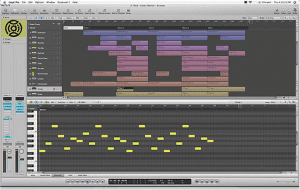MIDI Sequencing Basics

Virtual instrument sequencing is one of the fastest-growing trends among indie music makers. This is due to computing power becoming better and more affordable, and the quality of virtual instruments having become quite impressive.
Typically played through a MIDI controller, sequencing records your notes as MIDI data rather than audio. The data is typically presented in a piano roll window, which graphs the y-axis as pitch and the x-axis as time. That data is then used to playback your performance on a loaded virtual instrument, sometimes called a patch. While most DAWs offer some sequencing function, producers who use it often tend to prefer Cubase, Logic or Digital Performer.
For them it’s an easy way to add textures and cut down cost and production time. And for that reason, we wanted to do a brief intro into the basic benefits of sequencing.
Quantization
One of the greatest features of sequencing is the ability to quantize the notes played. What quantizing does is sync the notes up to a rhythmic grid. You can choose the division of the beat from a whole to (most times) a 32nd note. Often you can also choose to add “swing” to the quantization to add a bit of nuance and imperfection, making the playback sound more natural.
Quantization is great for laying down drum tracks, allowing you to fix any off rhythm beats in your performance and produce a track that sounds tight and in time.
Pitch Correction
Pitch correction does exactly what it says, corrects any wrong notes that were played. Most DAWs make fixing a wrong note insanely easy. The benefits of this feature are straighforward, as you don’t have to scrap an entire performance just because you missed one note. Talk about a time saver!
Arpeggiation
A newer feature in many DAWs is arpeggiation, which allows you to build complex patterns of notes from chords. You can often choose to have the notes ascend, descend, go up and then down, randomize or follow a predetermined pattern. Loading up different patches and playing with the arpeggiator is a great way to experiment with new ideas when you’ve hit a roadblock.
These are just some of the basic features that MIDI sequencing offers. From doing a quick scratch demo to composing a full band, the benefits of sequencing make producing music fast, easier and pretty fun. It’s also a great way to save some money when you can't afford to hire a professional musician.




